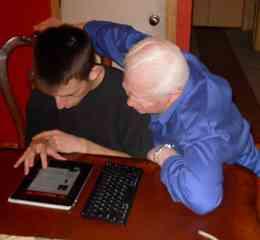Forging New Pathways in Keller ISD: Audio/Digital Books and Reading Technologies
 VI Teacher, Roger Price with student “J”
VI Teacher, Roger Price with student “J”Roger Price, a teacher in Keller ISD in Fort Worth, recalls many years of observing his blind and visually impaired students struggle to keep up with their reading assignments. In the past, these students were routinely burdened with heavy volumes of printed textbooks. Images and photos were low quality, text was black and white, and students would straddle their desks to read the large print – requiring extra space to accommodate their learning needs; all of which led to these students being labeled ‘different’ in class. Mr. Price says, “Advancements in reading technologies and the availability of accessible educational materials in digital and audio formats have given studentsmore freedom to forge new learning experiences.”
“Keller ISD has made technology and digital accessible books a priority for students with qualifying print disabilities,” said Jill Ross, Special Education Coordinator for the district. “Today, many of our students are comfortable using MacBooks, iPads, PC laptops and desktop computers to download and read digital text. Some use smart phones and devices such as the Braille Note Apex, PlexTalk audio and Bookport Plus.”
Mr. Price wants his students to read in braille first and then use digital text so they can hear information read aloud through text-to-speech. “This reinforces tactile learning and also enables students to improve their reading comprehension, spelling and grammar,” he said.
Students Forge New Pathways
Mr. Price shares the following stories about his students using digital books from Bookshare and reading technologies. Bookshare is an online accessible book library, free for U.S. students with qualifying print disabilities, through funding from the U.S. Department of Education, Office of Special Education Programs (OSEP).
“J” came to Keller ISD five years ago. He spoke no English and was on the verge of retinal detachment failure. Eventually “J” would lose his sight. Through the efforts of Mr. Price and teachers at the Texas School for the Blind, “J” became an avid reader of digital books. He learned how to use many electronic devices and is now very tech savvy. He is at the top of his class academically, speaks English well and is learning French. In general education classes, he signs on to the Bookshare website and downloads literature in English and Spanish to his iPad, MacBook or computer. “J” is an inspiration to all of us!” said Mr. Price.
“A” is an incessant reader and a graduate of Keller ISD. In the fall, she will attend the University of Texas, San Antonio. “A” uses a top-of-the-line Braille Note Apex. It’s a small and lightweight electronic device that she carries on her shoulder. On the Bookshare website, she finds the digital books she wants to read on this device. In high school, she took advanced literature classes and kept up her reading pace through the use of digital books and technologies. “Many students with vision difficulties get stumped when teachers give impromptu assignments, but not ‘A’, said Mr. Price. “She as comfortable using the refreshable braille device and downloading digital books as a sighted student is with opening a hardback book or using a technology device.”
“S,” a 10th grader, has severe cerebral palsy and low vision. His motorized wheelchair gets him to and from his classes. “He only types with one finger, but can quickly whip out his MacBook and navigate through digital text,” said Price. “Accessible formats enable him to more easily change font size, set color contrasts, and modulate speech. They are an equalizer for him!”
This year, Mr. Price and Ms. Ross watched “E,” an 8th grader with Stargardts Disease (also known as juvenile macular degeneration, a condition that causes extremely low vision) receive six distinguished learning awards in school. She took all advanced placement classes and reads a lot of digital books on her Plextalk, iPad and Kindle Fire.
“Without Bookshare and the portable technology devices, this student would not have kept pace with her peers in school,” said Price. “It’s such a contrast now from the days of learning with closed circuit TVs. My students are tech-savvy. They use the latest technologies and digital books and are the students who carry flash drives, download MP3 formats, use braille and text-to-speech. These advancements help them fit into a social norm and for the first time, the stigma of being labeled ‘different’ is finally fading.